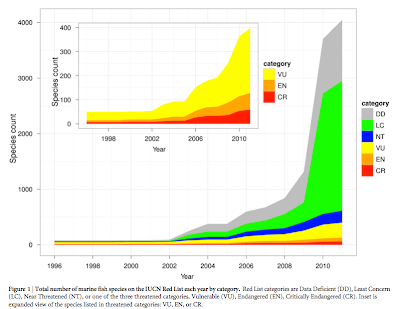The main disconnect between these two evaluation methods comes from the fact that for an exploited species to reach its maximum level of production, it needs to be fished down. Although the levels to which a stock is fished down varies by population and can be hotly debated, it often requires removing ≥50% of the original population, in order for the population growth rate to be maximized. Yet, despite the well-document and management-driven fishing down phase of a fishery, it is often assumed that this decrease in biomass may trigger a negative conservation status. For this reason, some conservationists see managed species at risk of extinction, while fishery managers—even for overfished species—rarely think about extinction.
 |
| Counts of Red List species by category. See Davies and Baum for details. |
Measuring the actual disconnect between these two evaluation methods is what Davies and Baum set out to examine in a Scientific Report in Nature last week.
The basic setup for their analysis was to collect Red List and stock assessment data for a number of marine species, and then classify the species or stock into one of four categories: positive hit, negative hit, false alarm, or miss. (Check out the figure below for more information.) The Red list criteria was simply threatened or not, and the stock assessment criteria was whether the stock was above or below its reference point, for example BMSY.
The authors are wise to note several considerations, such as the varying ecological levels of the two assessments (species vs. populations), the difference in how the two metrics are calculated (rate-based vs. biomass-based), and the fact that many Red List species do not have a stock assessment (not to mention the error involved in even the best stock assessments and the range of reference points available).
 |
| Western Pacific striped marlin are an example of a "miss"—below its biological reference point, but not Red Listed. (Photo) |
Davies and Baum do acknowledge that some species flagged by the Red List are likely just below their reference points and not in danger of extinction, but the real upshot here is the relatively high agreement between the two evaluation methods. Ultimately, they suggest that Red List status could serve to inform fisheries that do not have stock assessments and serve as warnings of overfishing.
This paper is open and can be downloaded freely here.
Steve Midway
Also, don't forget to let us know if you took a kid fishing so you can be entered to win a rod and reel combo!


No comments:
Post a Comment
Please leave a professional comment to create discussion about this topic. We reserve the right to remove any comment.